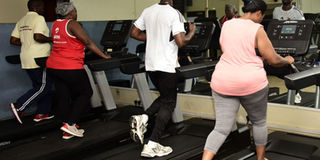The magic of exercises at work, how to achieve it

Fitness. Parliament staff work out during a gym session at the Parliament fitness club on Wednesday. Photo by PARLIAMENT PRESS
What you need to know:
Physical inactivity and work. Sedentary lifestyle affects both physical and mental health. Many people with desktop jobs claim they are too busy to spend even five minutes on exercises, without knowing the effect immobility has on their performance.
Many people with desktop jobs spend most of their time at work and wish they could get time off to workout. Apart from physical benefits, exercising has impact on the way we work.
Better focus
According to Stanford University’s department of Psychology, our mental firepower is directly linked to our physical regimen.
Similarly, Harvard Business Review says nowhere are the implications more relevant than to our performance at work. The cognitive benefits of physical exercise, which include improved concentration, sharper memory, faster learning, prolonged mental stamina, enhanced creativity, low stress are important during our work day.
Improves mood
“Exercise has also been shown to elevate mood, which has implications for workplace performance.” Harvard Business Review adds.
Boosts performance
Additionally, there is evidence suggesting exercise during regular work hours may boost performance. A study by Leeds Metropolitan University examined the influence of daytime exercise among workers with access to a company gym.
The study found out that “On days when employees visited the gym, their experience at work changed. They reported managing their time more effectively, being more productive, and having smoother interactions with colleagues. Just as important: They went home feeling more satisfied at the end of the day,” Harvard Business Review reports.
World Health Organisation advises that adults have at least 150 minutes of moderate intensity or 75 minutes of vigorous intensity physical activity per week or 30 minutes of moderate activity per day for five days.
Better health
Physical inactivity is reported as the 4th leading risk factor for death globally. It is estimated that one in every four adults globally is not physically active enough. Some of the factors that result in physical inactivity, according to Uganda non-communicable diseases risk factor survey (2014) included work settings that require long sitting hours, such as offices, markets and shops that are associated with minimal movement. How then can one ensure physical activity at work?
Setting up a workplace gym
Solomon Nsamba, a fitness instructor, shares that increasingly, companies are paying attention to the aspect of physical exercise to keep their employees healthy and productive at work. “I for example know workplaces that have a gym facility and instructors so that employees can access these amenities at any given time, freely. To be able to incorporate physical exercises at the work place, this is one of the amenities work places can think about having,” he says adding that this can be a way to avoid the ‘I have no time’ excuse by employees.
Gym partnerships
He, however, recognises that not every workplace can be able to have a budget to set up a gym or a designated workout area.
“Employers can make partnerships with fitness clubs or gyms for their employees, and have people divided into groups, with each group exercising at a given day or time. Alternatively, employers can invest in hiring a fitness instructor to engage their employees in physical exercise at a given period of time, for example after work, or in the morning before work,” Nsamba explains.
When asked the benefits of this to employees, Nsamba shares that this is another way of building teams that are accountable, especially for a workplace that relies largely on team work in their day to day work, It boosts social interaction amongst workers, especially when they work in groups, as well as bringing energy in the workplace after a workout.
However, on a personal level, one can boost their efficiency in the workplace by undertaking their own exercise routines.
Jamiru Mpiima, a nutritionist, says to stay physically active in the work place, workers can:
Walk during your lunch break
If you find that boring, buy a camera and walk around taking pictures. You can buy a pedometre for monitoring, or use a phone application to monitor movements.
Look for opportunities to stand
You will burn more calories standing than sitting. Stand while talking on the phone, for example.
Take fitness breaks
Rather than hanging out in the lounge with coffee or a snack, take a brisk walk or do some gentle stretching.
Conduct meetings on the good
When it is practical, schedule walking meetings or walking brainstorming sessions. Do laps inside your building or, if the weather allows, take your walking meetings outdoors.
Desk push-ups
(First, make sure your desk is solid enough to support your weight.) Standing, put your hands on the desk. Walk backward, then do push-ups against the desk. Repeat 15 times.
Stretch
Move your legs while waiting for a web page to load, or the copier to spit out your reports.
Sitting tall in your chair, stretch both arms over your head and reach for the sky. After 10 seconds, push the right hand higher, then the left. Let your head roll over so that your right ear nearly touches your right shoulder. Using your hand, push your head a little lower. Hold for 10 seconds. Relax, and then repeat this on the other side.
Take note
Put a reminder on your phone, desk calendar or sticky note on your computer to take exercise breaks.




